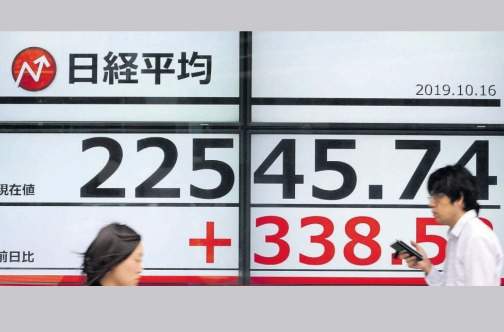TOKYO, Japan — Pedestrians walk in front of an electric quotation board displaying the numbers on the Nikkei 225 index of the Tokyo Stock Exchange, in Tokyo on October 16, 2019. (Photo: AFP)
The popular phrase is “higher risk is equal to higher returns”. This is a little misleading, because people fail to mention that it is simply the “potential” for a higher return.
Unfortunately, along with this sometimes-low chance of a high return, comes several risks. These include losing the original investment altogether, with the investment underperforming a low-risk comparable investment.
A loss of principal will mean that all the metrics/targets used to assess the success of the investment will be poor.
Assessing the risk of potential investments can’t take place until each investor has some sense of their risk tolerance. However, investors often misdiagnose their risk tolerance. They fail to use objective market data to inform this assessment.
While their risk tolerance is largely influenced by their investment objectives, age and net worth, it is also heavily impacted by the investment environment. For example: returns that were available on “relatively medium-risk investments” just five years ago, are now only available on some “relatively high-risk investments”.
Investors must clearly understand what returns are available for each level of risk before they choose a category.
How would you know which returns are reasonable in the current environment? This is probably the most critical part of risk assessment.
Investors should speak to the experts in the field so that they can get a realistic idea of the ranges that are likely in each asset class. In this way, when a number seems outside of the reference, you can query the reason for either the very low or very high return.
There are many different types of risks and they vary in importance depending on the investment you are considering. How can an investor preliminarily gauge the risk of an investment without a detailed time-consuming analysis?
Here is a shortcut: compare the return to a benchmark.
If you are considering a bond, compare the return to an index of bonds with a similar credit rating. For example, a misinformed bond investor may profess to be “low risk” but want a return in excess of 7 per cent per year. However, this is out of sync with the reality because “low-risk” yields are around 2 per cent and relatively higher-risk yields (according to the Bloomberg Barclays High Yield Bond index) are around 5.56 per cent.
Similarly, for equities, if you are considering a stock, compare the performance to that of the market. For example, if the Jamaica Stock Exchange (JSE) index has appreciated by 32 per cent but the stock or unit trust has appreciated by 24 per cent, it has underperformed the market. You would have been better off buying an index.
The cost of incorrectly assessing your risk tolerance can lead to you taking on much higher levels of risk than you originally assumed. There is no such thing as a low-risk 7 per cent yield in the current environment.
If investors are receiving a 7 per cent yield, they must understand the risks associated with it.
Take the time and research the target markets, find a realistic return for your level of risk tolerance and it just may lead to a reassessment of your preferences and portfolio allocation.
Yanique Leiba-Ebanks, CFA, FRM, B.S.B.A., is the AVP, pensions & portfolio investments at Sterling Asset Management. Sterling provides financial advice and instruments in US dollars and other hard currencies to the corporate, individual and institutional investor. Visit our website at www.sterling.com.jm Feedback: if you wish to have Sterling address your investment questions in upcoming articles, e-mail us at info@sterlingasset.net.jm.
http://www.jamaicaobserver.com/article/20191027/ARTICLE/191029756




Leave A Comment